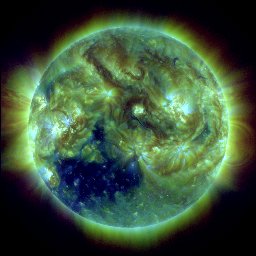|
|
|
 |
 |
 |
 |
|
|
 |
The AIA design is based on
science requirements (as detailed in the AIA proposal
LMSSC-P20017) that are compatible with the requirements formulated by the
SDO Science Definition Team and the LWS Science Architecture Team. This
design provides the following instrument capabilities:
- Seven EUV and three UV-visible channels (listed in
Table A1). Four of the EUV wavelength bands
open new perspectives on the solar corona, having never been
imaged or imaged only during brief rocket flights. The set of six EUV
channels that observe ionized iron
allow the construction of relatively narrow-band temperature maps
of the solar corona from below 1 MK to above 20 MK.
- A field of view exceeding 41 arcmin
(1.28 solar radii in the EW and NS directions),
with 0.6 arcsec pixels.
- A detector full well > 150,000 electrons and ~ 15 e/photon,
with a camera readout noise ~ 25 electrons.
- A sustained 10-s cadence during most of the mission.
- A capability to adjust the observing program to changing
solar conditions in order to implement observing programs
that are optimized to meet the requirements of specific scientific objectives.
This allows, for example, a 2 second cadence in a reduced
field of view for flare studies.
Table A1: AIA wavelength bands.
| Channel name | Primary ion(s) | Region of atmosphere* | Char.
log(T) |
| white light | continuum | photosphere | 3.7 |
| 1700Å | continuum | temperature minimum, photosphere | 3.7 |
| 304Å** | He II | chromosphere, transition region | 4.7 |
| 1600Å** | C IV+cont. | transition region + upper
photosphere | 5.0 |
| 171Å** | Fe IX | quiet corona, upper
transition region | 5.8 |
| 193Å** | Fe XII,
XXIV | corona and hot flare plasma | 6.1, 7.3 |
| 211Å** | Fe XIV | active-region corona | 6.3 |
| 335Å** | Fe XVI | active-region corona | 6.4 |
| 94Å** | Fe XVIII | flaring regions (partial readout
possible) | 6.8 |
| 131Å** | Fe VIII, XX, XXIII | flaring regions
(partial readout possible) | 5.6, 7.0, 7.2 |
* Absorption allows imaging of
chromospheric material within the corona;
** in baseline program
AIA will obtain images in multiple EUV and UV pass bands.
The basic observables are full-Sun intensities at a range of
wavelengths. Together, these will comprise the data archive, which is
freely accessible to the research community and, with limitations
dictated by resources, to other interested parties. Derived data
products, such as coronal thermal charts, maps of variability, and
comparisons to HMI magnetograms and to (non-)potential field
extrapolations will be made available regularly through the
data-processing pipeline for a subset of the data for use in
evaluation of the data and to aid the discovery of phenomena and
cataloging of events. Software will be made available to researchers
to create these data products for other datasets;
a core library of easy-to-use,
publicly-available software will be developed as part of the
SolarSoft IDL environment to enable and support the investigations that are
required to meet the primary AIA science goals.
For further details of the science requirements,
we refer at present to
the instrument description in the CSR science plan |
 |
 |
Back to Top |
 |
|
|
 |
|
|
 |
|

SDOGuide |
|  |
Guide to SDO Data Analysis. |
 |
|  |
 |
|
|
 |
|

SDO - Solar Physics |
|  |
Special SDO issue in Solar Physics. |
 |
|  |
 |
 |
|

SDOdocs |
|
Access and search documentation on SDO/AIA and related (meta-)data. |
|
 |
 |
 |
|

Sungate |
|
Access LMSAL solar data, search engines, knowledgebase, and instrument sites |
|
 |
 |
 |
|

iSolSearch |
|
Find solar events, summaries, movies, ... |
|
 |
 |
 |
|

Solar Sites |
|
A collection of web resources related to solar physics and related sciences |
|
 |
 |
 |
|

jhelioviewer |
|
Visualization software for solar data based on JPEG2000. |
|
 |
 |
 |
|

ADS Pubs |
|
AIA-related publications from the ADS. |
|
 |
 |
|

